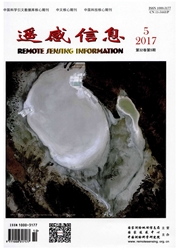

 中文摘要:
中文摘要:
鉴于研究城市热岛效应对监测气候变化、城市扩张等的重要指导作用,该文借助天津市夏季Landsat-5/7/8卫星热红外遥感数据,使用影像拼接技术获取几乎覆盖整个天津市的影像,并运用基于发射率校正的陆面温度反演模型得到1999年、2001年、2006年、2009年和2013年的近似地表温度分布图,以进行天津市近15年城市热岛演变分析研究;采用温度稳定比例的相对分级策略与首次提出的相对离散度指标,对天津市城市热岛进行整体分析,并对特殊局部和重点地区进行了细致分析,同时分析了中心城区-滨海新区沿线的温度变化情况。研究表明:天津市城区热岛分布呈现"由分化总,由总化分"的趋势,滨海新区热岛现象先增强后减弱,天津市北部近年来热岛现象加强,中心城区、滨海新区"双热岛"向中心城区-滨海新区沿海河线"热岛群"转变。
 英文摘要:
英文摘要:
With the acceleration of urbanization,the urban heat island effect is becoming more and more obvious,which has played an important role in climate change monitoring,urban expansion and so on.Series of Landsat satellite data were used to analyze the temporal and spatial evolution of Tianjin urban heat islands in recent 15 years.The summer Landsat images which covered Tianjin in 1999,2001,2006,2009 and 2013 are used in this paper.Image mosaic technology and the emissivity-corrected land surface temperature (LST)inversion model are conducted to obtain approximate LST data of almost the entire Tianjin. Then,the spatiotemporal evolution of UHI is examined and analyzed quantitatively by adopting the relative proportions and the relative dispersion respectively,and it is the first time the latter is proposed in this field.In addition,the specific areas and the key regions are contended intensively.Moreover,the UHI phenomenon within the central city and the Binhai New Area is also analyzed in this article.The results demonstrate that the UHI phenomenon in Tianjin is obvious,and it also shows a pattern of becoming striking at first and then less notable in Binhai New Area,while the phenomenon becomes remarkable in the northern part in recent years.Moreover,there is a considerable tendency that the UHI phenomenon in Tianjin is from centralized to scattered and then in turn.According to the illustrating temperature difference variation along central city and Binhai New Area, it can be seen that the UHI phenomenon along the two areas has gradually grown stronger gradually in recent years,and has transformed from two islands to island group along the line.
 同期刊论文项目
同期刊论文项目
 同项目期刊论文
同项目期刊论文
 Methods and strategy for modeling daily global solar radiation with measured meteorological data - A
Methods and strategy for modeling daily global solar radiation with measured meteorological data - A Impacts of transportation routes on landscape diversity: a comparison of different route types and t
Impacts of transportation routes on landscape diversity: a comparison of different route types and t Quantifying determinants of cash crop expansion and their relative effects using logistic regression
Quantifying determinants of cash crop expansion and their relative effects using logistic regression Spatially non-stationary response of ecosystem service value changestourbanization in Shanghai, Chin
Spatially non-stationary response of ecosystem service value changestourbanization in Shanghai, Chin Land use changes to cash crop plantations: crop types, multilevel determinants and policy implicatio
Land use changes to cash crop plantations: crop types, multilevel determinants and policy implicatio Enhanced adsorption of aqueous perchlorate on quaternary ammonium chloride surfactant-modified activ
Enhanced adsorption of aqueous perchlorate on quaternary ammonium chloride surfactant-modified activ 期刊信息
期刊信息
